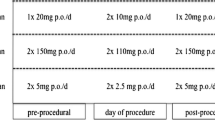Abstract
Purpose
Symptomatic intracerebral hemorrhages (ICHs) are a rare complication after atrial fibrillation (AF) catheter ablation, while the incidence of asymptomatic ICHs detected by magnetic resonance (MR) imaging remains unclear. This study aimed to investigate the incidence, characteristics, and predictors of new-onset ICHs on MR imaging after AF ablation.
Methods
We retrospectively studied 1257 consecutive AF ablation procedures in 1201 patients who underwent MR imaging on the day after the procedure. Repeat MR imaging within 3 months post-ablation was available in 352 procedures.
Results
Old ICHs on the initial MR imaging were observed in 28 procedures (2.2%). Post-ablation new ICHs were observed in 14 procedures (4.0%), including one symptomatic (0.3%) and 13 (3.7%) asymptomatic ICHs. One patient had a new ICH on the initial MR imaging, while the remaining 13 had such on the repeat MR imaging. A univariate analysis revealed that a previous ischemic stroke or transient ischemic attack (TIA) and the CHA2DS2-VASc score were positive predictors of new ICHs (odds ratios, 5.502 and 1.435; P = 0.004 and 0.044). The lesion diameter did not significantly differ between the old and new ICHs (median, 6.1 mm vs. 8.0 mm, P = 0.281), while the predominant location differed (lobar areas, 22.6% vs. 53.3%; cerebellum, 22.6% vs. 20.0%; others, 54.8% vs. 26.7%; P = 0.026).
Conclusions
A few asymptomatic ICHs may occur after AF ablation. Most of the post-ablation new ICHs occurred a few days or later after the procedure. A previous ischemic stroke/TIA and the CHA2DS2-VASc score may be risk factors for post-ablation ICHs.



Similar content being viewed by others
References
Cappato R, Calkins H, Chen SA, et al. Updated worldwide survey on the methods, efficacy, and safety of catheter ablation for human atrial fibrillation. Circ Arrhythm Electrophysiol. 2010;3:32–8.
Di Biase L, Lakkireddy D, Trivedi C, et al. Feasibility and safety of uninterrupted periprocedural apixaban administration in patients undergoing radiofrequency catheter ablation for atrial fibrillation: results from a multicenter study. Heart Rhythm. 2015;12:1162–8.
Di Biase L, Gaita F, Toso E, et al. Does periprocedural anticoagulation management of atrial fibrillation affect the prevalence of silent thromboembolic lesion detected by diffusion cerebral magnetic resonance imaging in patients undergoing radiofrequency atrial fibrillation ablation with open irrigated catheters? Results from a prospective multicenter study. Heart Rhythm. 2014;11:791–8.
Kuwahara T, Abe M, Yamaki M, et al. Apixaban versus warfarin for the prevention of periprocedural cerebral thromboembolism in atrial fibrillation ablation: multicenter prospective randomized study. J Cardiovasc Electrophysiol. 2016;27:549–54.
Martinek M, Sigmund E, Lemes C, et al. Asymptomatic cerebral lesions during pulmonary vein isolation under uninterrupted oral anticoagulation. Europace. 2013;15:325–31.
Ichiki H, Oketani N, Ishida S, et al. The incidence of asymptomatic cerebral microthromboembolism after atrial fibrillation ablation: comparison of warfarin and dabigatran. Pacing Clin Electrophysiol. 2013;36:1328–35.
Tao S, Otomo K, Ono Y, et al. Efficacy and safety of uninterrupted rivaroxaban taken preoperatively for radiofrequency catheter ablation of atrial fibrillation compared to uninterrupted warfarin. J Interv Card Electrophysiol. 2017;48:167–75.
Nakamura K, Naito S, Sasaki T, et al. Silent cerebral ischemic lesions after catheter ablation of atrial fibrillation in patients on 5 types of periprocedural oral anticoagulation-predictors of diffusion-weighted imaging-positive lesions and follow-up magnetic resonance imaging. Circ J. 2016;80:870–7.
Patil N, Arora S, Davis L, Akoum NW, Chung MK, Sridhar AR. Incidence and predictors of 30-day acute cerebrovascular accidents post atrial fibrillation catheter ablation (from the Nationwide Readmissions Database). Am J Cardiol. 2021;138:61–5.
Liu Y, Zhan X, Xue Y, et al. Incidence and outcomes of cerebrovascular events complicating catheter ablation for atrial fibrillation. Europace. 2016;18:1357–65.
Abdur Rehman K, Wazni OM, Barakat AF, et al. Life-threatening complications of atrial fibrillation ablation: 16-year experience in a large prospective tertiary care cohort. JACC Clinical electrophysiology. 2019;5:284–91.
Nakamura K, Naito S, Sasaki T, et al. Uninterrupted vs. interrupted periprocedural direct oral anticoagulants for catheter ablation of atrial fibrillation: a prospective randomized single-centre study on post-ablation thrombo-embolic and haemorrhagic events. Europace. 2019;21(2):259–67.
Nakamura K, Sasaki T, Take Y, et al. Impact of the type of electroanatomic mapping system on the incidence of cerebral embolism after radiofrequency catheter ablation of left atrial tachycardias. Heart Rhythm. 2020;17:250–7.
Guidelines for pharmacotherapy of atrial fibrillation (JCS 2013). Circ J. 2014;78(8):1997–2021.
Nakamura K, Sasaki T, Take Y, et al. Postablation cerebral embolisms in balloon-based atrial fibrillation ablation with periprocedural direct oral anticoagulants: a comparison between cryoballoon and HotBalloon ablation. J Cardiovasc Electrophysiol. 2019;30:39–46.
Bradley WG Jr. MR appearance of hemorrhage in the brain. Radiology. 1993;189:15–26.
Gomori JM, Grossman RI, Goldberg HI, Zimmerman RA, Bilaniuk LT. Intracranial hematomas: imaging by high-field MR. Radiology. 1985;157:87–93.
Inagawa T, Ohbayashi N, Takechi A, Shibukawa M, Yahara K. Primary intracerebral hemorrhage in Izumo City, Japan: incidence rates and outcome in relation to the site of hemorrhage. Neurosurgery. 2003;53:1283–97.
Pisters R, Lane DA, Nieuwlaat R, de Vos CB, Crijns HJ, Lip GY. A novel user-friendly score (HAS-BLED) to assess 1-year risk of major bleeding in patients with atrial fibrillation: the Euro Heart Survey. Chest. 2010;138:1093–100.
Srivatsa UN, Danielsen B, Anderson I, et al. Risk predictors of stroke and mortality after ablation for atrial fibrillation: the California experience 2005–2009. Heart Rhythm. 2014;11:1898–903.
Acknowledgements
We would like to thank Mr. John Martin, Satoshi Tomioka, and Hirohiko Shinbo for their help in the preparation of the manuscript.
Author information
Authors and Affiliations
Corresponding author
Ethics declarations
Conflict of interest
The authors declare no competing interests.
Additional information
Publisher's note
Springer Nature remains neutral with regard to jurisdictional claims in published maps and institutional affiliations.
Supplementary Information
Below is the link to the electronic supplementary material.
Rights and permissions
About this article
Cite this article
Nakamura, K., Sasaki, T., Minami, K. et al. Symptomatic and asymptomatic intracerebral hemorrhages detected by magnetic resonance imaging after catheter ablation of atrial fibrillation. J Interv Card Electrophysiol 64, 443–454 (2022). https://doi.org/10.1007/s10840-021-01051-6
Received:
Accepted:
Published:
Issue Date:
DOI: https://doi.org/10.1007/s10840-021-01051-6




